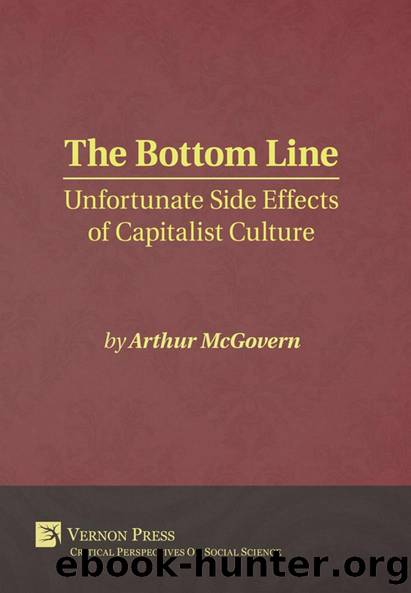The Bottom Line by Arthur McGovern

Author:Arthur McGovern [McGovern, Arthur]
Language: eng
Format: epub
ISBN: 9781622732449
Barnesnoble:
Publisher: Vernon Art and Science
Published: 2017-03-03T00:00:00+00:00
Galbraith suggested that ever increasing productive capacities of the economic system would influence the cultural values and norms regarding consumption so that, instead of tapering off, our desires would be relatively boundless, and he further pointed out that these consumer desires could be âsynthesized by advertising, catalyzed by salesmanship, and shaped by the discreet manipulations of the persuadersâ (Galbraith, 1958, p. 123). In The New Industrial State (1967), Galbraithâs main argument again was that producers and the market were no longer simply responsive to the consumer but were actively engaged in shaping consumer behavior:
The unidirectional flow of instruction from consumer to market to producer ⦠is no longer a description of the reality and is becoming ever less so. Instead the producing firm reaches forward to control its markets and on beyond to manage the market behavior and shape the social attitudes of those, ostensibly, that it serves (Galbraith, 1967, pp. 211-212).
The integration of material goods with the psychologies of individuals has also created new and complex relationships. The sociologist Karin Knorr-Cetina writes about the âways in which major classes of individuals have tied themselves to object worldsâ (1997, p. 1). According to Knorr-Cetina, âthe demise of community and traditions also leaves the individual in the lurch â without the psychological means to deal with the great freedom of choice or the contingency of contemporary lifeâ (1997, p. 4), and so individuals engage in what she calls an âobject-centred sociality,â which is the creation of object-centered environments that âsituate and stabilize selves, define individual identities just as much as communities or families used to do, and promote forms of sociality that feed on and supplement the forms of sociality studied by social scientistsâ (Knorr-Cetina & Breugger, 2000, p. 141). In fact, some of these theorists suggest that we may have reached a âpost-socialâ point in our evolution.
One distinctive characteristic of the contemporary scenario could be that perhaps for the first time in recent history it appears unclear whether, for individuals, other persons are indeed the most fascinating part of their environment â the part we are most responsive to and devote most attention to (p. 142).
Think of ATM machines and the demise of teller-based banking interactions. âWhen person-to-person services are replaced by automated electronic services, no social structures at all need to be in place â only electronic information structuresâ (Knorr-Cetina & Breugger, 2000, p. 6). The social and material relations in modern culture have therefore changed significantly. Consider the role of Twitter, a broadcast-type communication system that allows impersonal communications to reach a broad audience. Or consider users of Facebook and their tally of âfriends,â many of whom are, in fact, strangers with which the user has had no interaction.
Commodifying Culture
The term âculture industryâ was perhaps used for the first time in the book Dialectic of Enlightenment, written by the left-wing philosophers Theodore Adorno and Max Horkheimer in 1947. In it, they described how the capitalistic economic system had subverted cultural production and made it into a tool for perpetuating the domination of capitalism over the masses.
Download
This site does not store any files on its server. We only index and link to content provided by other sites. Please contact the content providers to delete copyright contents if any and email us, we'll remove relevant links or contents immediately.
| Anthropology | Archaeology |
| Philosophy | Politics & Government |
| Social Sciences | Sociology |
| Women's Studies |
Nudge - Improving Decisions about Health, Wealth, and Happiness by Thaler Sunstein(6643)
iGen by Jean M. Twenge(4705)
The Fire Next Time by James Baldwin(4351)
Adulting by Kelly Williams Brown(3681)
The Sports Rules Book by Human Kinetics(3597)
The Hacking of the American Mind by Robert H. Lustig(3588)
The Ethical Slut by Janet W. Hardy(3512)
Captivate by Vanessa Van Edwards(3306)
Mummy Knew by Lisa James(3174)
In a Sunburned Country by Bill Bryson(2953)
The Worm at the Core by Sheldon Solomon(2928)
Ants Among Elephants by Sujatha Gidla(2928)
Suicide: A Study in Sociology by Emile Durkheim(2615)
The Slow Fix: Solve Problems, Work Smarter, and Live Better In a World Addicted to Speed by Carl Honore(2578)
Humans of New York by Brandon Stanton(2382)
Handbook of Forensic Sociology and Psychology by Stephen J. Morewitz & Mark L. Goldstein(2380)
Blackwell Companion to Sociology, The by Judith R. Blau(2320)
The Happy Hooker by Xaviera Hollander(2276)
Outliers by Malcolm Gladwell(2263)
